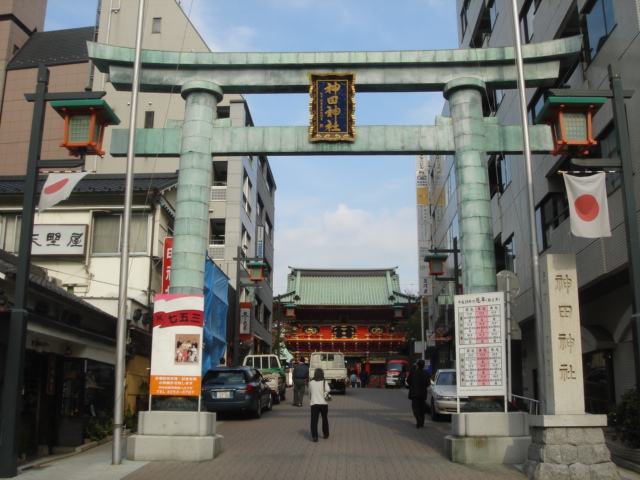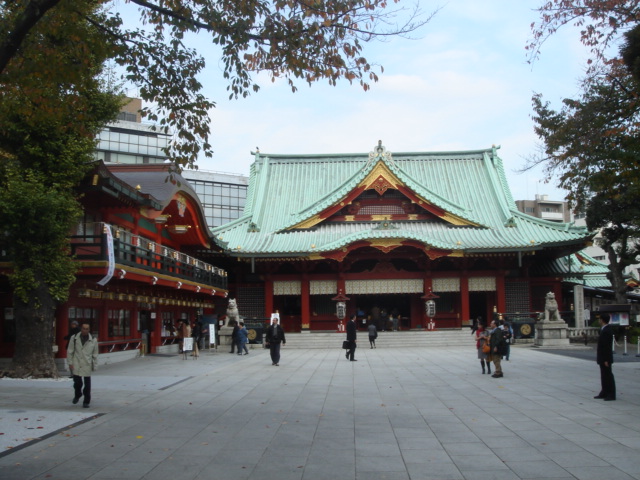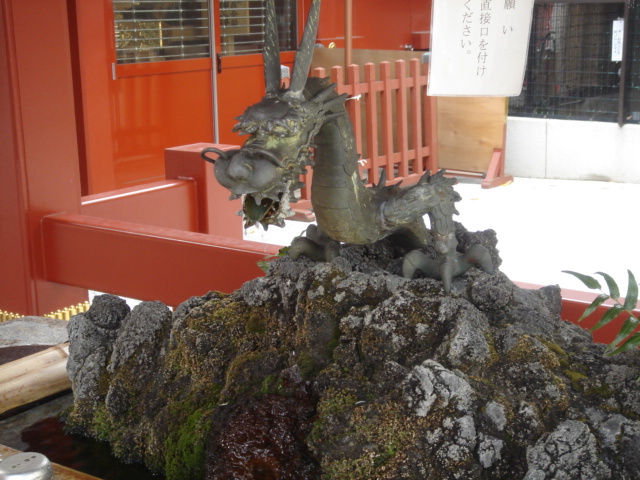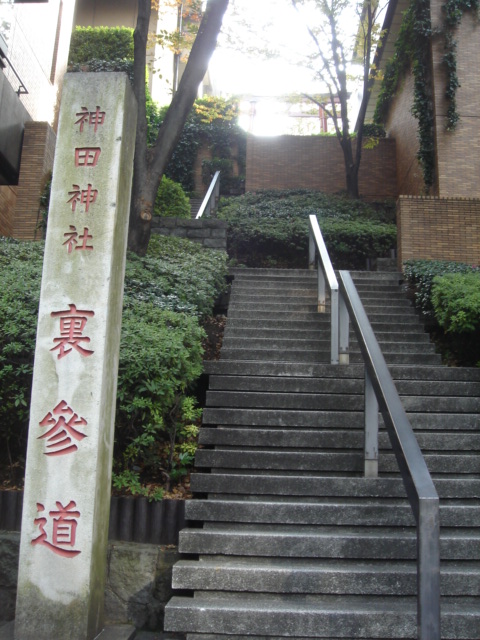
所在地 千代田区外神田2-16-2
社殿は登録有形文化財
社伝によると天平2年(730)、武蔵国豊島郡柴崎村の浜辺(現 平将門首塚 千代田区大手町1-2)創建されました。延慶2年(1309)、時宗二祖真教上人は東国の英雄で庶民たちに仰がれた平将門公の霊を当社に合祀し、太田道灌・北条氏綱といった名立たる武将によって手厚く崇敬されました。
慶長5年(1600)、天下分け目の関ヶ原の戦いで、当社は徳川家康公が合戦に臨む際、戦勝のご祈祷を行ないました。すると、慶長5年(1600)9月15日、神田祭の日に見事に勝利し天下統一を果たされました。これ以降、家康公の合戦勝利に因み縁起の御守り『勝守(かちまもり)』を授与するようになり、現在でも多くの参拝者に授与しております。徳川江戸幕府が開かれると幕府の深く尊崇するところとなり、元和2年(1616)に江戸城の表鬼門にあたる現在の地に遷座し幕府により社殿が造営されました。江戸時代を通じて江戸総鎮守として歴代の将軍はもとより江戸の庶民たちにも崇敬されました。
明治時代に入り東京・皇城の守護神として准勅祭社・東京府社に定められ、明治7年(1874)に明治天皇が親しく御参拝になりました。大正時代、関東大震災(1923)による社殿焼失後、昭和9年(1934)に氏子崇敬者の浄財により画期的な権現造の鉄骨鉄筋コンクリート・総漆塗の社殿が造営されました。
昭和20年(1945)、東京大空襲が神田・日本橋界隈を直撃しましたが、社殿はわずかな損傷のみで戦災を耐えぬき戦災で苦しむ人々に勇気と希望を与えました。
戦後、隨神門などの建造物などが再建され江戸時代にも劣らぬ江戸東京を代表する神社としての景観を整えるにいたりました。さらに平成七年より「平成の御造替事業」として社殿等の塗替・修復及び資料館の造営等が大規模に行われ、平成17年(2005)には境内の整備事業が実施され、鳳凰殿や祖霊社などが新たに造営されました。

【 御祭神 】
一の宮 大己貴命(おおなむちのみこと)(別名 大国主命)
<だいこく様> 平成2年(730)創祀
二の宮 少彦名命(すくなひこなのみこと)
<えびす様> 明治7年(1874)奉祀
三の宮 平将門命(たいらのまさかどのみこと)
<まさかど様> 延慶2年(1309)奉祀

【 神田祭 】
日本三大祭・江戸三大祭のひとつに数えられる代表的な日本の祭です。
江戸の昔より、徳川将軍をはじめ江戸庶民の厚い崇敬を受けたことから天下祭・御用祭とも称えられ、神田・日本橋を中心とする町々より36本の勇壮な山車と、それに加え毎回趣向を凝らして人々の目を楽しませた附祭(つけまつり)も加わり江戸城内に参入して徳川将軍の上覧にあずかった由緒ある祭礼です。
今日の神田祭は、2年に一度賑やかに行われます。当社の鳳輦・神輿三基をはじめとする平安絵巻さながらの祭礼行列が東京の中心である神田・日本橋・秋葉原・大手町・丸の内の氏子108ヶ町を一日がかりで巡行します。また、各氏子の町神輿約200基が街中を練り歩き、次々と宮入参拝する様は実に壮観です。蔭祭の年には、当社の宮神輿が氏子中により担がれ渡御いたします。

境内には『随神門』、『少彦名命(えびす様)ご尊像』、『大己貴命(だいこく様)ご尊像』、『鉄製天水桶』、『小唄塚・小唄作詞塚』、『水盤』、『力石』、『銭形平次碑』、『石獅子』、『角田竹冷の句碑』、『水野年方顕彰碑』、『籠祖神社』、『籠祖講関係石造物群』、『三宿稲荷神社・金刀比羅神社』、『浦安稲荷神社』、『末広稲荷神社』、『魚河岸水神社』、『小舟町八雲神社』、『小舟町八雲神社の鉄製天水桶』、『大伝馬町八雲神社』、『大伝馬町八雲神社の鉄製天水桶』、『江戸神社』、『国学発祥の地碑』、『阿部宵人の句碑』、『明治天皇御臨幸記念碑』、『献燈台奉献の碑』、『銭形平次の作者 野村胡堂ゆかりの紅梅』、『明神男坂』、『明神女坂』があります。
Edo Sochinju Kanda Myojin
Kanda Shirine,the Tutelary Shrine of All Edo
〔Deities Enshrined〕
Ichi-no-miiya(First Shrine):Onamuchi-no-mikoto("Daikoku-sama")
Ni-no-miya(Second Shrine):Sukunahikona-no-mikoto("Ebisu-sama")
San-no-miya(Third Shrine):Taira no Masakado-no-mikoto("Masakado-sama")
Kanda Shrine is formally known as Kanda JInja but is also more popularly called Kanda Myojin.The deities enshrined are the guardian deities for 108 Tokyo neighborhoods,including Kanda,Nihombashi,Akihabara,Ohte-Marunouchi,the Old Kanda Market and the Tsukiji Fish Marked.Prayers to the deities enshrined at Kanda Myojin are partivularly efficacious for family happiness,marriage,prosperity and success in business,recobery from illness,and protection against accidents and disasters,among many other things.
〔History〕
Kanda MYojin was founded in 730(the 2nd year of the tempyo era,or Tempyo 2).With its almost 1,300 years of history,the shrine is one of the oldest in Tokyo.Originally,it was located near the Masakado-zuka (Masakado Tomb)in present-day Chiyoda-ku,not far from the Imperial Palace.In 1309 (Enkei 2),Taira no Masakado(903?-940),a famous warrior hero of Eastern Japan,was enshrined at Kanda Myojin.In 1603 (Keicho 8),when Shogun Tokugawa Ieyasu established his government in Edo(now Tokyo)and rebuilt Edo Castle on a larger scale,the shogunate moved Kanda Shrine to its present site in order to guard against misfortune entering the castle from the inauspicious Omote Kimon(demon gate)direction.Throughout the Edo period,many people both in the government and among the general public honored the shrine as the Tutelary Shrine of All Edo.
During the Meiji period (1868-1912),Kanda Myojin was named one of the ten shrines in Tokyo to which an Imperial emissary was sent on the occasion of festivals and was officially regarded as the guardian of the City of Tokyo and the Imperial Palace.In 1874,another deity,Sukunahiko-no-mikoto,who was originally worshipped at Oharai Isosaki Shrine in Ibaragi Prefecture,was enshrined as the second guardian deity of Kanda Myojin.It was also in this year that Emperor Meiji paid a personal visit to the shrine.
Following the destruction of the shrine complex in the Great Kanto Earthquake of 1923,the shrine buildings were rebuilt in Gongen style,but instead of the traditional wood,reinforced concrete was used,an innovation in shrine-construction methods.The fire bombing of Tokyo in 1945 nearly destroyed the Kanda and Nihombashi areas,but the shrine buildings survived with only minimal damage.
After the war,the Zuishin Gate and other structures were rebuilt,restoring the shtine to its Edo-period grandeur as one of the most important and scenic shrines of Tokyo.In 1995,as part of the Heisei Grand Restoration Project,the shrine buildings were thoroughly refurbished and a new museum was added to the complex.In 2005,further renovation work was carried out,and the new Ho-ou-den (Phoniw Hall)and Soreisha(Shrine for Ancestral Sporits)were built.
〔Shirine Precincts〕
The Kanda Shrine complex has been designated a National Cultural Property.The buildings are constructed In the Gongen style of reinforced concrete painted with vermilion lacquer.The Zuishin Gate is built entirely of hinoki cypress in the Irimoya style.Decorating the gate are carved wooden reliefs depicting such subjects as the legend of the white ravvit of Inava,the four mythical vreatures of the four directions,and a tethered horse,which was Taira no Masakado's family emblem.The Ho-ou-den is a multifunctional hall where talismans can be obtained and worshipers can rest their feet or wait for triends.The Myojin Kaikan(the shrine hall)is used for various ty;es of gatheringa,invluding wedding receptions for couples who have been married at the shrine.The Shiryokan(the Shrine Museum)exhibits important artifacts related to the history of Edo culture and the Kanda Festival.Within the shrine precincts aremany sculptures,including images of Daikoku-sama(the largest stone sculpture of Daikoku-sama in Japan)and Ebisu-sama coming ashore amid waves,and also cultural properties such as the Shishi-yama(Lions on the cliff),the Tensui-oke(the Temsui pail) and other monuments.
〔Kanda Matsuri〕
The Kanda Matsuri is one of the three most famous festivals in Japan and also one of the three great festivals of Edo.During the Edo preod,the Kanda Matsuri was supported by both th government and the people of Edo and thus became known as the Edo Tenka Matsuri (the Edo Grand Festival) and Goyo Matsuri (Government-Authorized Festival).During th festival,elaborately decorated floats and parades of costumed townspeople came from the Kand and Nihombashi neighborhoods to Edo Castle,where they were permitted to enter the parace grounds to entertain the shogun.
Today the Kand Matsuri is held once every two years in May.It consists of two main events.During the Jinkosai (Deity Parade Festival),the shrine's own horen (imperial palanquins) and mikoshi (portable shrines)are paraded through the streets of the 108 neighborhoods that regard Kanda Myojin as their tutelary shrine.Then during the Mikoshi-miyairi,the machi-mikoshi--mikoshi belonging to individual neghborhood associations-- are carried through their respective neighborhoods and on to Kanda Shrine in a glorious pageant of color,movement,noise,and energy,to be purified and blessed by the deities of the shrine.
In alternate years when the full Kanda Matsuri is not held,one of Kanda Shrine's grand mikoshi is also carried through the neighborhood on the shoulders of houndreds of people with a lot of cheers and enthusiasm.
PR






